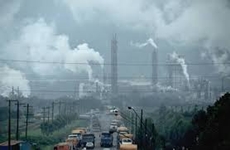Obama to unveil tougher Climate Act as pollution bites
03 Aug 2015
President Barack Obama will unveil the final version of his action plan to tackle greenhouse gases from coal-fired power plants that would require reduction of carbon emissions by up to 32 per cent by 2013, against the earlier draft regulation that required cuts by up to 30 per cent.
 Raising the ceiling on emission cuts will kick off legal tussle between federal environmental regulators and coal industry supporters, but the regulation will encourage an aggressive shift toward renewable energy, pushing utilities to invest even more heavily in wind and solar energy.
Raising the ceiling on emission cuts will kick off legal tussle between federal environmental regulators and coal industry supporters, but the regulation will encourage an aggressive shift toward renewable energy, pushing utilities to invest even more heavily in wind and solar energy.
Gina McCarthy, administrator of the US Environmental Protection Agency (EPA), told reporters the Obama administration's plan to raise carbon emission limits of power plants to 32 per cent by 2030 is squarely ''within the four corners'' of the Clean Air Act.
Speaking to reporters on Sunday, White House adviser Brian Deese said the new EPA rules represented the ''biggest step that any single president has made to curb the carbon pollution that is fuelling climate change''.
A White House statement said, ''Taken together these measures put the United States on track to achieve the president's near-term target to reduce emissions in the range of 17 per cent below 2005 levels by 2020, and lay a strong foundation to deliver against our long-term target to reduce emissions 26 to 28 per cent below 2005 levels by 2025.''
Several states and industry groups have, however, opposed the Obama administration's decision to amend pollution regulations to tackle climate change rather than attempt to pass the so-called ''cap and trade'' legislation or implement a carbon tax.
Those who have relied on coal-based energy have vowed to challenge the new requirements in the courts and through Congressional manoeuvres, accusing the administration of a regulatory assault that will drive up energy prices.
"These will burden Americans with increasingly high-costs for an essential service and a less reliable electric grid for delivering it," said Hal Quinn, president of the National Mining Association.
Critics also argue that lower-income Americans will bear the heaviest burden of compliance.
The National Rural Electric Cooperative Association, which represents co-ops that deliver energy to poor rural communities, said it projects the Clean Power Plan will raise electricity prices by at least 10 per cent, a rise that would be disproportionately felt by "the country's most vulnerable populations."
 At the same time, EPA's Gina McCarthy pointed out the severe effects of carbon pollution that is fueling climate change, saying it is leading to more extreme droughts, storms, fires and floods that directly threaten public health.
At the same time, EPA's Gina McCarthy pointed out the severe effects of carbon pollution that is fueling climate change, saying it is leading to more extreme droughts, storms, fires and floods that directly threaten public health.
''And it's often those most vulnerable - our children, elderly, and disadvantaged communities - who suffer the most. We're already seeing those impacts today.
The severe drought in California is raising the risk of West Nile Virus, as infected birds and insects come into closer contact near dwindling water sources. Mold that grows in buildings following flooding can cause respiratory illness. And more extreme temperatures can be deadly.
''Carbon pollution also comes packaged with other harmful air pollutants like smog and soot that can cause heart and lung disease, she said.
She said the EPA is finalising a Clean Power Plan that would help Americans avoid up to 100,000 asthma attacks and 2,100 heart attacks in the same year from reduced smog and soot.
The Obama administration also rejected the criticism that the plan was intended to accelerate a transition toward producing more electricity from renewable fuels.
The White House said release of the plan was "the starting gun for an all-out climate push" by the president and his cabinet.
"My administration will release the final version of America's Clean Power Plan, the biggest, most important step we have ever taken to combat climate change," Obama said in a video posted online by the White House.
Coal accounted for 39 per cent of electricity generated in the US in 2014, according to the Department of Energy.
Natural gas' 30 per cent share of US electricity generation would remain largely the same in 2030 while renewable energy would account for 28 per cent, up from the 22 per cent initially envisioned in the proposed rule. Nuclear currently provides around 20 percent of the US energy mix.













.jpg)






.jpg)









